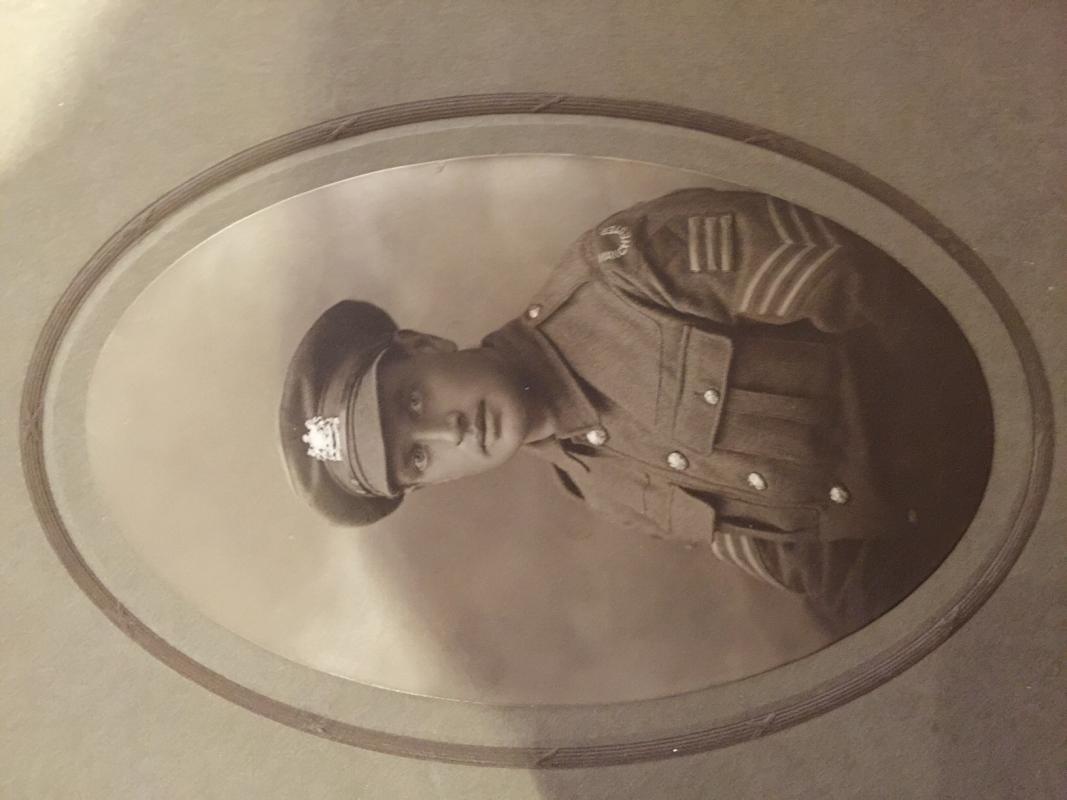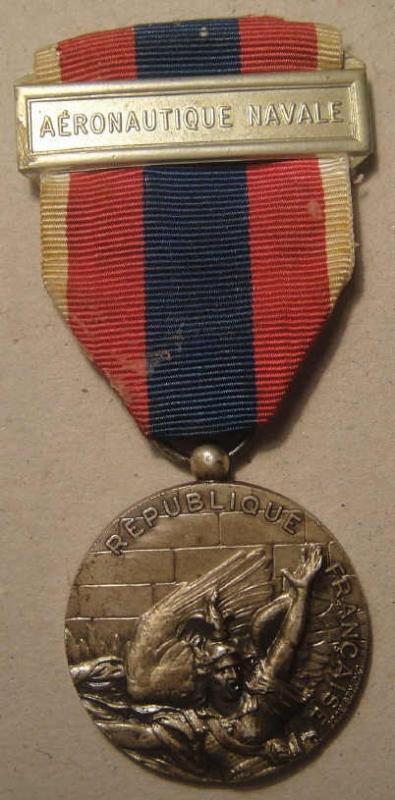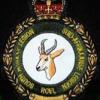-
Posts
232 -
Joined
-
Last visited
Content Type
Profiles
Forums
Blogs
Gallery
Events
Store
Posts posted by Strapper
-
-
Thanks Tony...I will be buying that.
0 -
Thank you Odulf. Not sure on the date of the Picture. Due to his rank and date of death I would assume it would be between mid 1916 and late 1917.
0 -
This is my Great Grandfather Sgt. Harold Hetherington Williams. 2nd Manchester Regimant. Can anyone give me info. On the three stripes above the Sergeant stripes and what they were doing when he was killed on 5th December 1917. I would greatly appreciate it
Kindly
strapper
0 -
This is my Great Grandfather Sgt. Harold Hetherington Williams. 2nd Manchester Regimant. Can anyone give me info. On the three stripes above the Sergeant stripes and what they were doing when he was killed on 5th December 1917. I would greatly appreciate it
Kindly
strapper 0
0 -
-
My great Grandfathers print works at Withygrove Manchester signed up and had heavy casualties if one looks at the Print Works Brass roll of Honour plaque. Serjeant Harold Hetherington Williams, wounded, died at a dressing station that was under such pressure with the mounting casualties that the bodies were discarded. He has no known grave. A typesetter by trade, as was his son (my grandfather) as was I. Remembered on a monument in France to the missing. His wife and baby son were left to make a living with no support, his wife died 10 years later from a broken heart (exhaustion).
The stories of the WW1 battalions are still very personal, 100 years on.
0 -
I wonder how one would go about telling the difference between the real thing and the hundreds of badges made for the movie. I have seen too many of these 5 Commando badges for sale to feel comfortable. I still see props from Zulu Dawn coming up for sale, so with the movie badges being nearly 37 years old,one wonders how many out there are props. With Col Mike on set, they must have got the uniforms pretty on the button.
0 -
Sometimes memories are more valuable than land....I like that Yossi, there are a few country's that should take note of your idea there!
0 -
Standing at the war museum in Johannesburg a few years back, under the South African War (boer war) memorial, I heard this engine noise I had previously only heard described to me, and a Spitfire flew over, D-Day markings, totally un announced and out of the blue...literally. Those Merlin RR engines are beautiful to hear...and so distinctive. Loved it!
0 -
Well spotted spasm, his last painting I saw in December was a WW2 North African bayonet charge at Night,, think he wanted a few hundred rand for it:-( he never knew what to charge ( exscuse the pun....charge..bayonet....)
Cheers D.
0 -
Denys Biden lost his right arm in North Africa in an incident that killed the rest of his platoon. He, unlike some loved to talk about his exploits over a few whisky's. Taught himself to paint with his left hand, he was a regular at art exhibitions in the Eastern Cape. Victim of a failed attempt to replace a pacemaker, Denys passed away aged 93, sound of mind and body till the end. Why doctors carry out procedures on people of that age that are not in a life threatening situation I will never know. We have so few WW2 left....go in peace Mr Biden.
0 -
Awesome...truly deserve to make some good money from your work.
Someone should do an article on your work to showcase it.
Kind Regards
D.
0 -
My first French Medal...and I think it's great!
 0
0 -
Well..I think that article stirred up some spirited responses...so god bless the little thing, good or bad. :-)
0 -
I think Kipling's son was not sickly, but very short sighted. Which is not really a " can't serve" disability. It was however a valid excuse for those with the lack of willingness to serve, to have a valid excuse. I'm sure his son was as eager to serve , as Kipling was to get him in. We should also remember that little was known of the futility and horrors to come when first signing up. They relied more on the Victorian sense of duty, it is only with hind sight and our loss of these lofty Victorian principles that we and Kipling judge his actions. It may have all turned out very differently if his son had been an officer in a different war, or had survived the First World War. No-one could have predicted the slaughter of European youth at a time when Sabres and cavalry horses were more common on the battlefield than machine guns.
0 -
Thank you Mark, an excellent website and great picture of our family gravestone:-)
Regards
David Strappini
0 -
Thanks all for the information on Bert, he was my grandfathers brother, and killed so young he hardly had time to impact on anyone's lives besides his parents and siblings, and of course those in his battery. I was also wondering why he wasn't in the RGLI like most of the men, but in an " English" unit. But thanks for the info on the pic, I can stop scanning the faces for any family resemblance..dammit.
Kind regards and thank you
David Strappini
0 -
I don't profess to have seen a lot of uniforms, but these bring to life those black and white photos we all have. I'm always amazed at how tight or tailored combat gear used to be, we are all used to fatigues now. Going to war in a jacket and tie, with lace up office type shoes is a bit wierd to me. Also in observation...how small the men were, uniforms I have seen, their proportions are almost dainty, some tunics I have seen would fit a modern (skinny) twelve year old, never a full grown man. The textures, stiffness and roughness of some materials is astounding. I'm surprised they could dress in it in trench conditions.
Kind regards
Strapper. ( and thanks for a most interesting forum)
0 -
Grandfather. Serjeant Royal Guernsey Light Infantry. Lewis Gunner. Wounded 1916, returned to unit. Never would talk about the war, said it upset him too much, and he felt that wasn't dignified for an old man upset himself....pity.
0 -
I think that a rule was made that brothers cannot serve in the same unit in the British army after WW1. Also the creation of units based on towns and geographical areas was also abolished after WW1. So the philosophy that units made up of your friends and family were stronger units, became unpopular due to family's, parishes, towns and suburbs of cities, if not whole islands taking massive casualties on one day. My grand father was in the Royal Guernsey light Infantry, a tiny british island, that saw brothers, fathers and sons and cousins, all killed in the same action. In World War Two, his three sons were split in units as far apart as you could get...Iceland, Gold Coast, and Britain. When I joined the South African Defence force the same year as my brother, we were told that it would not be possible for us to be based in the same unit. The SADF took a lot of its workings from the British army. So even in the 1980s this policy was still applied.
0 -
I tried to sell my soul at the crossroads , so i could buy this medal group, but Old Nick said my soul already had a few markers on it already, best he could do was a standard WW2 set with air crew star and bar....drat!
0 -
Well...its nice to see the Americans pick the right side for a change. Mind you, supporting Boers in 1901 was probably like supporting south vietnam in 1967, or south korea in 1950, or Mujahidin in afghanistan in 1980, or Iraq against iran . Hell im suprised America didn't back the Nazis in WW2, it would tie in perfectly with their " how to back the wrong horse" policy of foreign intervention.
0 -
Most luftschultz helmets are rather small, apparently it was often the job of young boys of thirteen or fourteen, obviously, hitler youth.They usuall fell under the normal luftschultz, but chech the size, that will give a clue to the age of the owner. I bet it is small...
0 -
I have seen a few of these type. The religious figure of Jesus seems to be replaced by girlfriends and mothers in later cards, maybe the horrors of war caused a questioning of religion and replacement with a comfort figure closer to home. Just a thought.
0




Drawings
in Non Military Collectibles & Antiques
Posted
James Ensor...Artist
Ensor's father, James Frederic Ensor, born in Brussels of English parents,[1] was a cultivated man who studied engineering in England and Germany.[2] Ensor's mother, Maria Catherina Haegheman, was Belgian. Ensor himself lacked interest in academic study and left school at the age of fifteen to begin his artistic training with two local painters. From 1877 to 1880, he attended the Académie Royale des Beaux-Artsin Brussels, where one of his fellow students was Fernand Khnopff. Ensor first exhibited his work in 1881. From 1880 until 1917, he had his studio in the attic of his parents' house. His travels were very few: three brief trips to France and two to the Netherlands in the 1880s,[3] and a four-day trip to London in 1892.[4]
During the late 19th century much of his work was rejected as scandalous, particularly his painting Christ's Entry Into Brussels in 1889(1888–89), but his paintings continued to be exhibited, and he gradually won acceptance and acclaim. In 1895 his painting The Lamp Boy (1880) was acquired by the Royal Museums of Fine Arts of Belgium in Brussels, and he had his first solo exhibition in Brussels.[5] By 1920 he was the subject of major exhibitions; in 1929 he was named a Baron by King Albert, and was the subject of the Belgian composer Flor Alpaerts's James Ensor Suite; and in 1933 he was awarded the band of the Légion d'honneur. Even in the first decade of the 20th century, however, his production of new works was diminishing, and he increasingly concentrated on music—although he had no musical training, he was a gifted improviser on the harmonium, and spent much time performing for visitors.[6] Against the advice of friends, he remained in Ostend during World War II despite the risk of bombardment. In his old age he was an honored figure among Belgians, and his daily walk made him a familiar sight in Ostend. He died there after a short illness, on 19 November 1949.